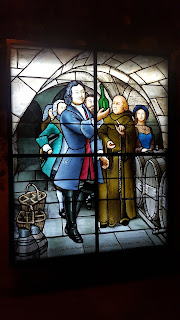We had the good fortune to taste champagne in the Champagne region for my big birthday. How did this come about? Well, when we looked at the host cities for the Women's World Cup in France, we noticed that one of them, Reims, was the unofficial capital of the Champagne region and from there it seemed obvious, where else would one celebrate their 50th birthday?
We have never been big champagne aficionados. Although we have resolved to drink more sparkling wine on various occasions, champagne was never a favorite. It tends to give Jeff a headache and the bubbles make you feel full quickly, so a bottle can go to waste. And it seems that good champagne is way more expensive than good wine. Still, we are open to new experiences and it certainly looked pretty and romantic.
As you probably know, champagne can only come from the Champagne region. Otherwise it’s sparkling wine, or prosecco (from Italy) or cava (from Spain). So, what is it that makes champagne so special? Well, let’s start with the kilometers of caves carved out of the chalk underneath the cities of Reims and Epernay. These caves are the perfect place to age champagne because they always maintain a temperature of 12 degrees Celsius and a constant (high) humidity.
We visited three big champagne houses on our trip: Mumm (cave in photo above), Taittinger, and Moet & Chandon. Each provided a tour that included a walk through the labyrinth of caves, with an explanation of their history and the process of making champagne. We learned a lot. Here are the highlights.
Champagne can be made with three types of grapes: chardonnay, pinot noir and meunier. If only white grapes (chardonnay) are used, it is a blanc de blanc. If only red grapes are used, it is a blanc de noir (although it will still be a white wine). And if it is infused with red wine or the skins of the red grapes are used it is a rose. Interestingly, Champagne is the only region in France where red and white grapes may be mixed together.
What makes champagne unique is that, unlike regular (still) wine, it goes through a second fermentation process. During this process the wine gains its effervescence through the addition of yeast, which eats sugar and emits carbon dioxide. The wine ages for a minimum of 18 months, although generally it is left for at least 3 years or longer by most champagne makers. Depending on the quality of the champagne, it can age for 5-10 years or longer before the yeast is removed, and then additional sugar is added, and the champagne is corked and aged further. This means that the champagne makers age the bottle for you and if you buy champagne it is ready to drink. So no need to hold on to it! One big difference with wine.
Another major difference was notable to us – champagne generally will not have a year on the bottle. This is because the majority of champagne is made with a blend of grapes (from the three types) from various years. Champagne will only have a year listed if it is made with grape harvested from a single year (called vintage champagne) – and this is the exception because most harvests are not of sufficient quality to merit this effort. We learned that each brand of Champagne is intended to have a consistent taste and the way the houses accomplish this is by blending, including reserving wine from previous years and blending it with the present year.
We enjoyed the tour and the champagne the most at Mumm. Taittinger was interesting and elegant. Their caves are some of the oldest (dug out by the Romans), sit under a former abbey/cathedral (the stairway was used by the monks), and they even commemorate that Peter the Great visited:
Moet was the most arrogant. They mentioned more than once – well, like every other sentence – that they produce the most champagne and that Napoleon visited often. No joke, if we played a drinking game based on taking a sip every time they name-dropped Napoleon we’d still be hung over. But what do you expect from the most-corporate champagne house in existence? (They are part of the Louis Vuitton Moet Hennesy luxury brand conglomerate and have truly maximized the marketing value of champagne.) Here is their atrium roof and a photo of a port barrel that was a gift from . . . you guessed it, Napoleon:Moet also owns the Dom Perignon brand, which only makes vintage champagne that is aged a minimum of 10 years. In their [exit-through-the] gift shop they displayed this amazing celebratory champagne flute tree for wedding celebrations (a bargain at about 4000 Euros):
Overall, we gained a new appreciation for champagne and perhaps will drink more of it in the future. We certainly would consider another visit to the region to explore more.
Cheers,
Shana & Jeff







No comments:
Post a Comment